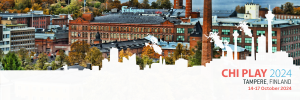Calling all game enthusiasts! Whether you’re into game development, game design, game studies, or anything in between, join us for the Game Creators Barcamp.
When: December 6th, 2024 from 13:15 to 16:00
Where: HS 4, Klagenfurt University
A Barcamp is an open, participant-driven event. There’s no pre-set schedule—you create the content! Attendees can sign up on-site on the day to host an (up to) 20-minute-session. This can be a game-related talk, a discussion, or an on-stage demo.
Some topics to explore might include:
- Game development
- Game design
- Game studies
- Playtesting and prototyping
- Stories and non-linear narratives
- Sound and music for games
- Podcasting and streaming about games
as well as novel and groundbreaking ideas for games
This is a chance to share your knowledge, explore new ideas, or simply connect with others who share your passion for games. Whether you’re a seasoned developer, an indie creator, a GSE student, or just curious, you’re welcome to take part in shaping the day!
🔗 Sign up to host a session on-site, or just come along and join the conversation!









